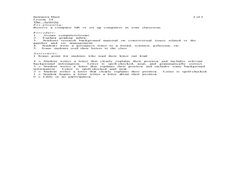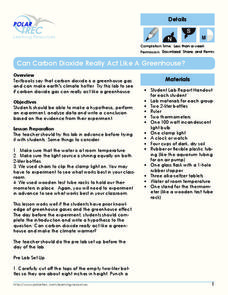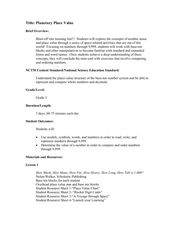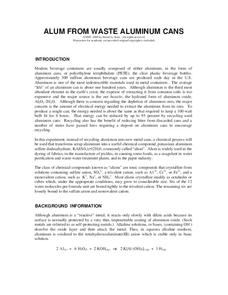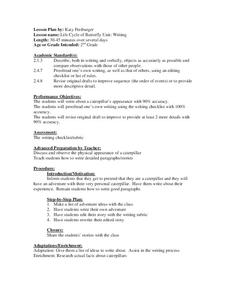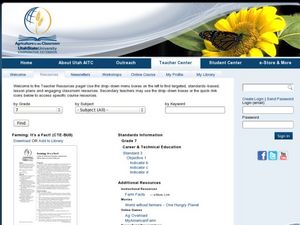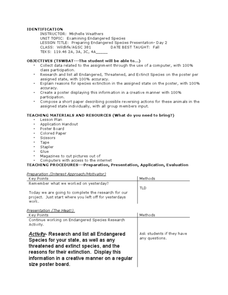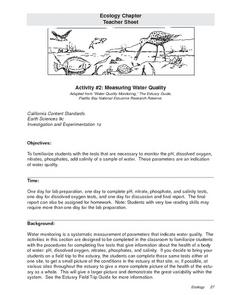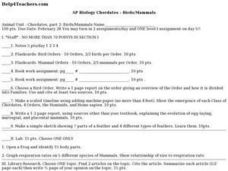Curated OER
My View's Write!
After researching issues involving panthers, middle schoolers practice writing persuasive letters. They become familiar with a controversial issue related to panthers and write their position on the issue. This lesson...
It's About Time
Monitoring Active Volcanoes
The fastest growing volcano in recorded history grew more than 150 meters in less than a week and to more than 424 meters in less than a decade. How do we safely monitor active volcanoes? Young scientists design an...
Polar Trec
Can Carbon Dioxide Act Like a Greenhouse Gas?
Ninety-seven percent of scientists who study climate agree that human activity is warming the planet. Learners explore carbon dioxide as a greenhouse gas, a gas causing this warming, through a hands-on experiment. Once complete, they...
Roland Park Country School
Butterfly or Moth?
What is the main difference between a moth and a butterfly? Butterflies have club-shaped antennae, while moths have a feather-like antennae. But what else differentiates these beautiful insects? The presentation in the resource...
Curated OER
Scaling it Down: Caves Have Maps, Too
Measurement and map skills are the focus of this lesson, where students crawl through a "cave" made out of boxes, desks and chairs, observing the dimensions. Your young geographers measure various aspects of the cave and practice...
Curated OER
Planetary Place Value
Third graders explore place value to the ten thousands place. This incredibly thorough, 24-page lesson has learners construct, order, and compare numbers to 9,999. This three-day lesson includes reteaching and extension activities...
Chymist
Alum from Waste Aluminum Cans
Turn aluminum cans into pickles! An engaging experiment has learners chemically change aluminum into a substance with many purposes including the manufacture of pickles. After performing the chemical conversion, the experimenters verify...
Curated OER
Life Cycle of Butterfly
Second graders investigate life cycles of insects by writing a story. In this butterfly life lesson, 2nd graders create a checklist of the many steps a caterpillar takes before growing wings and flying. Students utilize...
Curated OER
Chemical Composition of American Coins
High schoolers investigate the chemical composition of pennies dated 1983 or later. In this chemical composition of American coins lesson plan, students scratch the surface of the penny to expose the zinc core. They put the penny in...
Curated OER
Science Vocabulary
Students examine Science in present day life. In this oral communication lesson, students discuss and rank scientific events from least to most important. Students discuss their responses and why they are different....
Curated OER
Farming: It's a Fact!
Students use worksheets, food items, and computer programs to learn about the path of food from the farm to their meals. In this agriculture lesson, students use a provided worksheet to learn facts about farming. They use a bag of...
Curated OER
Examining Endangered Species
Middle school environmental science classes research the threatened, endangered, and extinct organisms listed for their state. They design and construct a poster of the information gleaned and write an essay about how they might be able...
Curated OER
Ecology Scavenger Hunt
Who doesn't love a scavenger hunt? Have your class complete a scavenger hunt to become familiar with ecology in this engaging activity that has them organize their items on a paper bag to illustrate information. Furthermore, learners...
Curated OER
REPRODUCTION
Students complete a variety of activities to study different concepts in Science. The activities are part of a layered curriculum. This is used to differentiate instruction and give a wide variety of assessment opportunities.
Curated OER
Astronomy: Earth/Moon
Students investigate the Earth and the Moon. They select activities from a menu of options including viewing videos, drawing magnetic fields and plate tectonics, creating vocabulary flashcards, observing the phases of the moon over a...
Curated OER
Combining Elements to Form a Compound
Students explore elements and compounds. For this lesson about elements and compounds, students will do an experiment. Students work in groups of 2-3 as they complete two separate activities. Students understand how two elements combine...
Curated OER
Dirt Babies
What exactly is a dirt baby, you might ask. Look over the plan to find out! All of the materials and procedures necessary for creating a dirt baby, such as grass seeds, dirt, and nylon stockings, are listed, along with ideas for...
Curated OER
Measuring Water Quality
High schoolers are introduced to the various methods of measuring water quality. In groups, they test various water samples using the different methods, writing them down for pH, oxygen, salinity, and nitrate levels. They use their...
Curated OER
Rainforest
Young scholars explore and study an activity that reinforces counting skills and drawing rain forest animals in their math storybooks. They brainstorm what type of animals they think they'd see in the rain forest, birds as well as...
Curated OER
Tadpoles to Frogs!
Third graders observe the tadpoles/frogs and draw a picture in their journals every week to monitor its growth with 100% accuracy. They observe tadpoles/frogs and record at least two changes or the observations the tadpole undergoes...
Curated OER
AP Biology Chordates - Birds/Mammals
Students participate in a layered curriculum units with a variety of activities like: Library Research and choose one topic. Find 2 articles on the topic, cite the article, and summarize each article.
Curated OER
Bison Eating
Fifth graders use metric measurement to study the amount a bison eats. In this measurement lesson, 5th graders watch a video about bison and discuss the amount of food they eat. Students weigh their food trays at lunch and complete a...
Curated OER
Cell Reviews
Students draw cells, make a cell, and list organelles in plant and animal cells. In this cells lesson plan, students create edible cells.
Curated OER
Up, Up and Away
Fourth graders design and launch rockets. In this rocket lesson, 4th graders observe the changes in outcome caused by size and fuel variables. Students navigate the NASA website to learn the parts of a rocket. Students load the...
